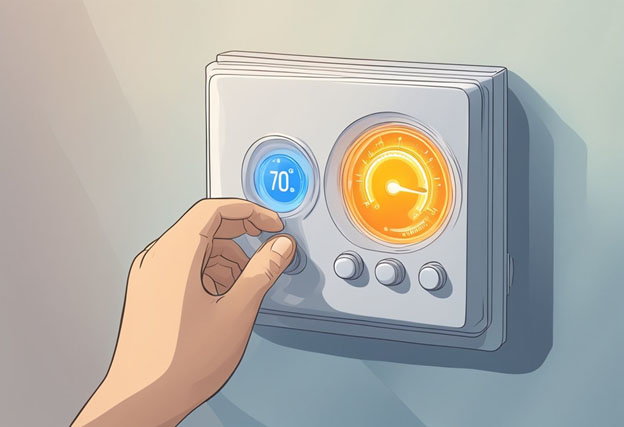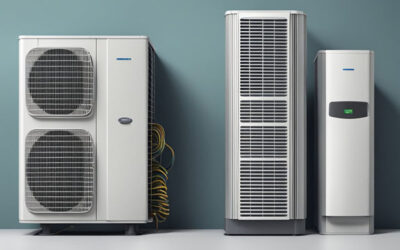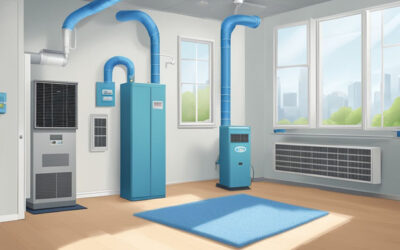Setting your thermostat lower won’t cool your home faster, yet many people believe this common misconception. In reality, your air conditioning system works at a consistent pace to cool your home, regardless of the temperature setting.
Lowering the thermostat temperature beyond your desired level can actually result in wasted energy and higher electricity bills. This is because your air conditioning system will continue to run at the same pace until it reaches your desired temperature, regardless of how low you set the thermostat.
Understanding the science behind your air conditioning system can help you save money and energy. By setting your thermostat to your desired temperature and avoiding the temptation to lower it, you can keep your home comfortable while also reducing your carbon footprint.
Understanding Thermostat Operation
How Thermostats Work
Thermostats are devices that regulate the temperature of your home by turning your HVAC system on and off. They work by measuring the temperature of the air in your home and comparing it to the temperature you have set on the thermostat. If the temperature is higher than the set temperature, the thermostat will turn on your air conditioning to cool your home. Conversely, if the temperature is lower than the set temperature, the thermostat will turn off your air conditioning.
Modern thermostats are digital and programmable, allowing you to set different temperatures for different times of the day. This feature helps you save energy by automatically adjusting the temperature when you’re away or asleep.
Myths About Cooling Speed
Many people believe that setting their thermostat lower will cool their home faster. However, this is not true. The air conditioning system works at a fixed rate, and turning down the thermostat will not make it work any faster. In fact, it may even cause your system to work harder and longer, resulting in higher energy bills.
Another common myth is that leaving your air conditioning on all day will save you money. This is also false. It’s more energy-efficient to turn off your air conditioning when you’re not home and turn it back on when you return. You can also use a programmable thermostat to automatically adjust the temperature based on your schedule.
In conclusion, understanding how your thermostat works can help you save energy and money. Don’t fall for common myths about cooling speed and energy efficiency. Instead, use your thermostat wisely to keep your home comfortable and your energy bills low.
Optimal Thermostat Settings for Efficiency
Recommended Temperature Settings
Setting your thermostat to the optimal temperature can help you save energy and money. The recommended temperature for your home during the summer months is 78°F (25.5°C). This temperature is comfortable for most people and allows your air conditioning system to run efficiently.
During the winter months, the recommended temperature for your home is 68°F (20°C) during the day and 62°F (16.5°C) at night. These temperatures are comfortable and can help you save money on your heating bill.
Energy Saving Tips
There are several things you can do to save energy and money on your heating and cooling bills:
- Use a programmable thermostat to automatically adjust the temperature when you are away from home or sleeping.
- Keep your thermostat away from sources of heat such as lamps, televisions, and windows.
- Use ceiling fans to circulate air and make your home feel cooler during the summer months.
- Keep your air filters clean to ensure that your air conditioning system is running efficiently.
- Use shades or curtains to block out sunlight during the hottest parts of the day.
By following these tips and setting your thermostat to the optimal temperature, you can save energy and money while keeping your home comfortable.
Factors Affecting Cooling Efficiency
When it comes to cooling a home, setting the thermostat lower won’t cool it faster. Rather, it can lead to energy wastage and higher bills. There are several factors that affect cooling efficiency, including:
Home Insulation Quality
The quality of insulation in a home can significantly impact cooling efficiency. Poor insulation can result in air leaks, which allow warm air to enter the home and cool air to escape. As a result, the air conditioner has to work harder to maintain the desired temperature, leading to higher energy consumption and bills.
To improve cooling efficiency, homeowners should consider upgrading their insulation. This can include adding weatherstripping to doors and windows, sealing air leaks, and installing insulation in the attic and walls.
Air Conditioner Capacity
The capacity of the air conditioner is another critical factor that affects cooling efficiency. An air conditioner that is too small for the size of the home will struggle to cool it adequately, leading to longer run times and higher energy consumption.
On the other hand, an air conditioner that is too large for the home will cycle on and off frequently, leading to energy wastage and higher bills. To ensure optimal cooling efficiency, homeowners should choose an air conditioner that is appropriately sized for their home.
By addressing these factors, homeowners can improve cooling efficiency and reduce energy consumption and bills.
Improving Home Cooling Without Lowering the Thermostat
Enhancing Air Circulation
One way to improve home cooling without lowering the thermostat is to enhance air circulation. This can be achieved by using ceiling fans or portable fans to circulate the air throughout the room. By doing so, the cooled air is distributed evenly, making the room feel cooler and more comfortable.
Another way to enhance air circulation is to keep the doors and windows open during cooler parts of the day, such as early morning and late evening. This allows fresh air to circulate through the house and can help to lower the overall temperature.
Regular Maintenance Tips
Regular maintenance of the air conditioning unit can also help to improve home cooling without lowering the thermostat. This includes cleaning or replacing air filters regularly to ensure that the air conditioning unit is running efficiently. Dirty filters can restrict airflow and make the unit work harder, which can lead to higher energy bills and less effective cooling.
It is also important to check the air conditioning unit’s coils and fins regularly and clean them if necessary. Dirty coils and fins can also restrict airflow and reduce the unit’s efficiency.
In addition, sealing any air leaks in the home can help to prevent cool air from escaping and hot air from entering. This can be done by sealing gaps around doors and windows with weatherstripping or caulking.
By following these tips, homeowners can improve home cooling without having to lower the thermostat, which can lead to lower energy bills and a more comfortable living environment.
Smart Thermostats and Cooling Efficiency
Benefits of Smart Thermostats
Smart thermostats are designed to help homeowners regulate their home’s temperature more efficiently. They are equipped with advanced features that allow them to learn the homeowner’s preferences and adjust the temperature accordingly. By doing so, they can help homeowners save energy and reduce their utility bills.
One of the key benefits of smart thermostats is their ability to provide remote access and control. This means that homeowners can adjust the temperature of their home from anywhere, using their smartphone or tablet. This feature is particularly useful for those who are away from home for extended periods, as it allows them to ensure that their home is not being unnecessarily cooled.
Another benefit of smart thermostats is their ability to provide detailed energy usage reports. This allows homeowners to monitor their energy consumption and identify areas where they can make changes to reduce their energy usage. By doing so, they can save money on their utility bills and reduce their carbon footprint.
How Smart Thermostats Can Mislead
While smart thermostats can be a useful tool for improving cooling efficiency, they can also be misleading. Many homeowners mistakenly believe that setting their thermostat lower will cool their home faster. However, this is not the case.
In fact, setting the thermostat lower than the desired temperature can actually result in wasted energy and increased cooling costs. This is because the air conditioning system will continue to run until it reaches the desired temperature, regardless of how low the thermostat is set.
Smart thermostats can also be misleading in terms of their energy savings claims. While they can help homeowners save energy and reduce their utility bills, the amount of savings will vary depending on a number of factors, including the size of the home, the climate, and the homeowner’s energy usage habits.
Overall, while smart thermostats can be a useful tool for improving cooling efficiency, homeowners should be careful not to rely too heavily on them. It is important to understand how they work and to use them in conjunction with other energy-saving strategies, such as sealing air leaks and improving insulation.





0 Comments